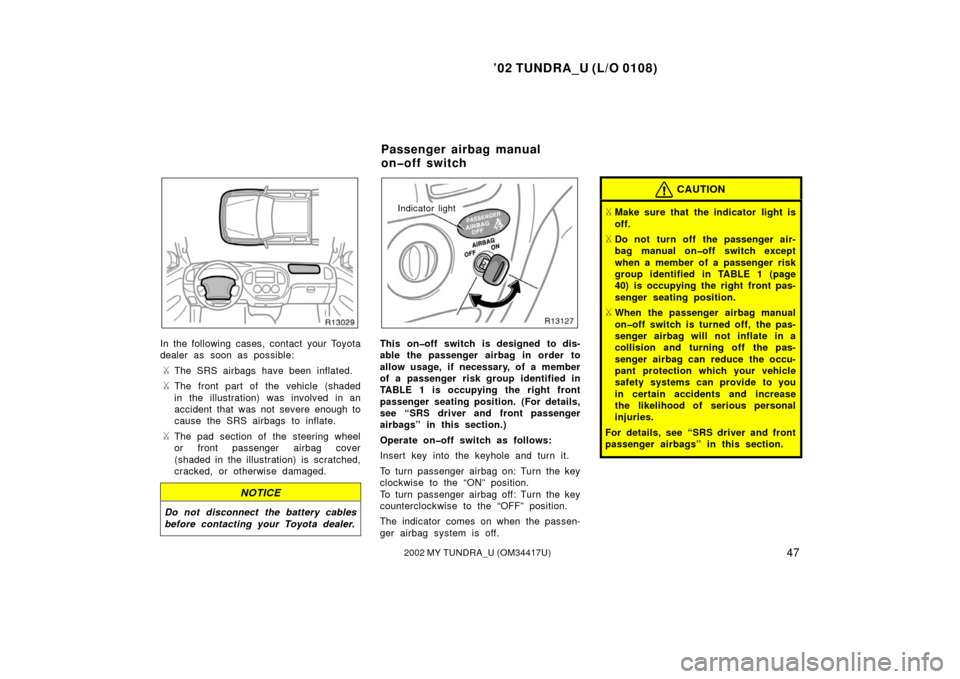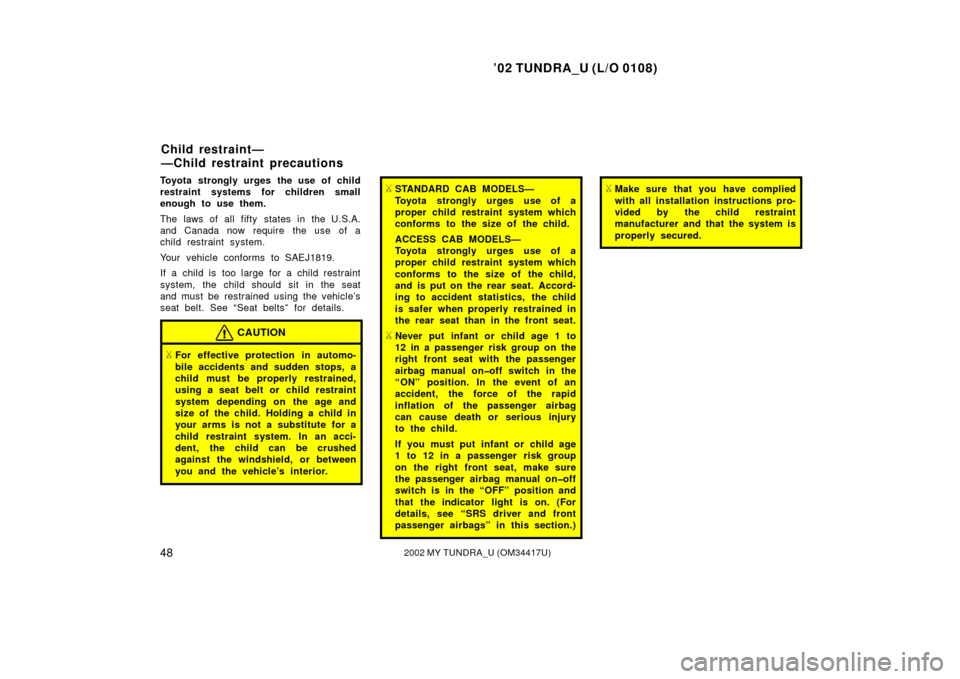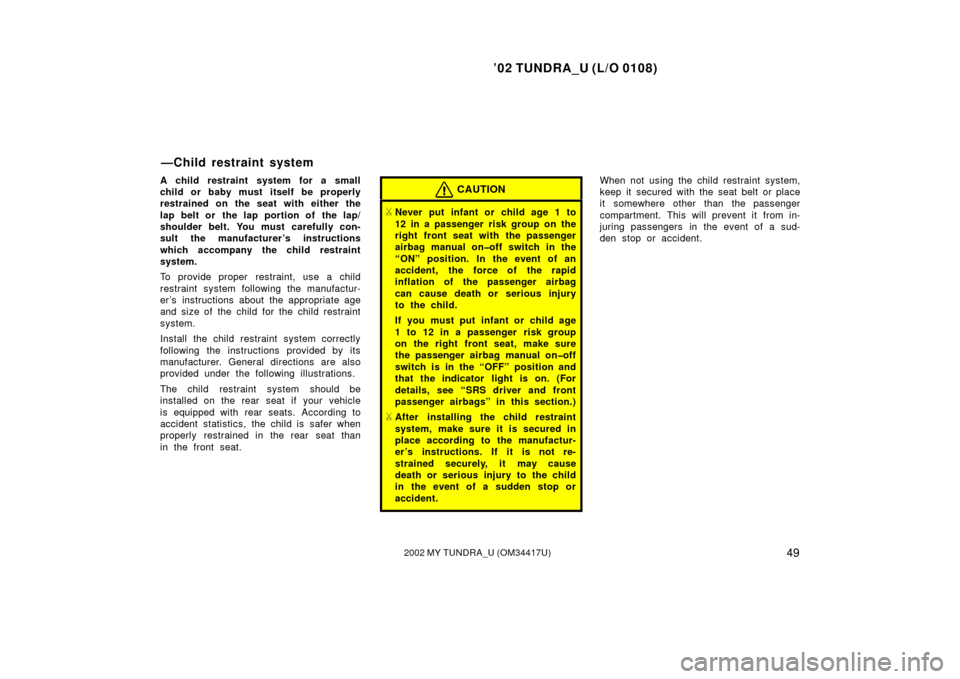Page 54 of 299

’02 TUNDRA_U (L/O 0108)
472002 MY TUNDRA_U (OM 34417U)
In the following cases, contact your Toyota
dealer as soon as possible:
�The SRS airbags have been inflated.
�The front part of the vehicle (shaded
in the illustration) was involved in an
accident that was not severe enough to
cause the SRS airbags to inflate.
�The pad section of the steering wheel
or front passenger airbag cover
(shaded in the illustration) is scratched,
cracked, or otherwise damaged.
NOTICE
Do not disconnect the battery cables
before contacting your Toyota dealer.
Indicator light
This on�off switch is designed to dis-
able the passenger airbag in order to
allow usage, if necessary, of a member
of a passenger risk group identified in
TABLE 1 is occupying the right front
passenger seating position. (For details,
see “SRS driver and front passenger
airbags” in this section.)
Operate on�off switch as follows:
Insert key into the keyhole and turn it.
To turn passenger airbag on: Turn the key
clockwise to the “ON” position.
To turn passenger airbag off: Turn the key
counterclockwise to the “OFF” position.
The indicator comes on when the passen-
ger airbag system is off.
CAUTION
�Make sure that the indicator light is
off.
�Do not turn off the passenger air-
bag manual on�off switch except
when a member of a passenger risk
group identified in TABLE 1 (page
40) is occupying the right front pas-
senger seating position.
�When the passenger airbag manual
on�off switch is turned off, the pas-
senger airbag will not inflate in a
collision and turning off the pas-
senger airbag can reduce the occu-
pant protection which your vehicle
safety systems can provide to you
in certain accidents and increase
the likelihood of serious personal
injuries.
For details, see “SRS driver and front
passenger airbags” in this section.
Passenger airbag manual
on�off switch
Page 55 of 299

’02 TUNDRA_U (L/O 0108)
482002 MY TUNDRA_U (OM 34417U)
Toyota strongly urges the use of child
restraint systems for children small
enough to use them.
The laws of all fifty states in the U.S.A.
and Canada now require the use of a
child restraint system.
Your vehicle conforms to SAEJ1819.
If a child is too large for a child restraint
system, the child s hould sit in the seat
and must be restrained using the vehicle’s
seat belt. See “Seat belts” for details.
CAUTION
�For effective protection in automo-
bile accidents and sudden stops, a
child must be properly restrained,
using a seat belt or child restraint
system depending on the age and
size of the child. Holding a child in
your arms is not a substitute for a
child restraint system. In an acci-
dent, the child can be crushed
against the windshield, or between
you and the vehicle’s interior.
�STANDARD CAB MODELS—
Toyota strongly urges use of a
proper child restraint system which
conforms to the size of the child.
ACCESS CAB MODELS—
Toyota strongly urges use of a
proper child restraint system which
conforms to the size of the child,
and is put on the rear seat. Accord-
ing to accident statistics, the child
is safer when properly restrained in
the rear seat than in the front seat.
�Never put infant or child age 1 to
12 in a passenger risk group on the
right front seat with the passenger
airbag manual on�off switch in the
“ON” position. In the event of an
accident, the force of the rapid
inflation of the passenger airbag
can cause death or serious injury
to the child.
If you must put infant or child age
1 to 12 in a passenger risk group
on the right front seat, make sure
the passenger airbag manual on�off
switch is in the “OFF” position and
that the indicator light is on. (For
details, see “SRS driver and front
passenger airbags” in this section.)
�Make sure that you have complied
with all installation instructions pro-
vided by the child restraint
manufacturer and that the system is
properly secured.
Child restraint—
—Child restraint precautions
Page 56 of 299

’02 TUNDRA_U (L/O 0108)
492002 MY TUNDRA_U (OM 34417U)
A child restraint system for a small
child or baby must itself be properly
restrained on the seat with either the
lap belt or the lap portion of the lap/
shoulder belt. You must carefully con-
sult the manufacturer ’s instructions
which accompany the child restraint
system.
To provide proper restraint, use a child
restraint system following the manufactur-
er ’s instructions about the appropriate age
and size of the child for the child restraint
system.
Install the child restraint system correctly
following the instructions provided by its
manufacturer. General directions are also
provided under the following illustrations.
The child restraint system should be
installed on the rear seat if your vehicle
is equipped with rear seats. According to
accident statistics, the child is safer when
properly restrained in the rear seat than
in the front seat.CAUTION
�Never put infant or child age 1 to
12 in a passenger risk group on the
right front seat with the passenger
airbag manual on�off switch in the
“ON” position. In the event of an
accident, the force of the rapid
inflation of the passenger airbag
can cause death or serious injury
to the child.
If you must put infant or child age
1 to 12 in a passenger risk group
on the right front seat, make sure
the passenger airbag manual on�off
switch is in the “OFF” position and
that the indicator light is on. (For
details, see “SRS driver and front
passenger airbags” in this section.)
�After installing the child restraint
system, make sure it is secured in
place according to the manufactur-
er’s instructions. If it is not re-
strained securely, it may cause
death or serious injury to the child
in the event of a sudden stop or
accident.
When not using the child restraint system,
keep it secured with the seat belt or place
it somewhere other than the passenger
compartment. This will prevent it from in-
juring passengers in the event of a sud-
den stop or accident.
—Child restraint system
Page 58 of 299
’02 TUNDRA_U (L/O 0108)
512002 MY TUNDRA_U (OM 34417U)
(A) INFANT SEAT INSTALLATION
An infant seat is used in rear�facing
position only. With the child restraint system installed,
check that your driving position is satis-
factory and that the child restraint system
does not interfere with your driving.
If your driving position is not satisfactory,
or the child restraint system interferes
with your driving, install it at another posi-
tion.
CAUTION
Ignoring the above instructions may
result in a serious injury in case of
an accident.
CAUTION
Never put a rear�facing child restraint
system on the front seat with the
passenger airbag manual on�off
switch in the “ON” position. In the
event of an accident, the force of the
rapid inflation of the front passenger
airbag can cause death or serious in-
jury to the child.
—Installation with 2�point
type seat belt
Page 59 of 299
’02 TUNDRA_U (L/O 0108)
522002 MY TUNDRA_U (OM 34417U)
When you put a rear�facing child re-
straint system on the front seat, turn
the passenger airbag manual on�off
switch counterclockwise to the “OFF”
position. (For details, see “SRS driver
and front passenger airbags” in this
section.)
The indicator comes on when the system
is off.
CAUTION
If you must put a rear�facing child
restraint system on the front seat,
make sure the passenger airbag
manual on�off switch is in the “OFF”
position and that the indicator light is
on.
CAUTION
�Do not put a rear�facing child re-
straint system on the rear seat if
the child restraint system interferes
with the front seat lock mechanism
or with your proper driving posi-
tion. This can cause death or seri-
ous injury to the child and front
passenger in case of sudden brak-
ing or a collision.
�If your driving position is not satis-
factory, install the child restraint
system at another position.
Page 62 of 299
’02 TUNDRA_U (L/O 0108)
552002 MY TUNDRA_U (OM 34417U)
CAUTION
Ignoring the above instructions may
result in a serious injury in case of
an accident.
CAUTION
Rear�facing child restraint system:
Never put a rear�facing child restraint
system on the front seat with the
passenger airbag manual on�off
switch in the “ON” position. In the
event of an accident, the force of the
rapid inflation of the front passenger
airbag can cause death or serious in-
jury to the child.
When you put a rear�facing child re-
straint system on the front seat, turn
the passenger airbag manual on�off
switch counterclockwise to the “OFF”
position. (For details, see “SRS driver
and front passenger airbags” in this
section.)
The indicator comes on when the system
is off.
Page 63 of 299
’02 TUNDRA_U (L/O 0108)
562002 MY TUNDRA_U (OM 34417U)
CAUTION
If you must put a rear�facing child
restraint system on the front seat,
make sure the passenger airbag
manual on�off switch is in the “OFF”
position and that the indicator light is
on.
CAUTION
Forward�facing child restraint system:
A forward�facing child restraint sys-
tem should never be put on the front
seat with the passenger airbag manu-
al on�off switch in the “ON” position,
because the force of the deploying
airbag could cause death or serious
injury to the child in forward seating
position.
CAUTION
�Do not put a rear�facing child re-
straint system on the rear seat if
the child restraint system interferes
with the front seat lock mechanism
or with your proper driving posi-
tion. This can cause death or seri-
ous injury to the child and front
passenger in case of sudden brak-
ing or a collision.
�If your driving position is not satis-
factory, install the child restraint
system at another position.
Page 66 of 299
’02 TUNDRA_U (L/O 0108)
592002 MY TUNDRA_U (OM 34417U)
CAUTION
Never put a rear�facing child restraint
system on the right front seat with
the passenger airbag manual on�off
switch in the “ON” position. In the
event of an accident, the force of the
rapid inflation of the front passenger
airbag can cause death or serious in-
jury to the child.
When you put a rear�facing child re-
straint system which belongs to a pas-
senger risk group on the right front
seat, turn the passenger airbag manual
on�off switch counterclockwise to the
“OFF” position. (For details, see “SRS
driver and front passenger airbags” in
this section.)
The indicator comes on when the system
is off.
CAUTION
If you must put a rear�facing child
restraint system on the right front
seat, make sure the passenger airbag
manual on�off switch is in the “OFF”
position and that the indicator light is
on.